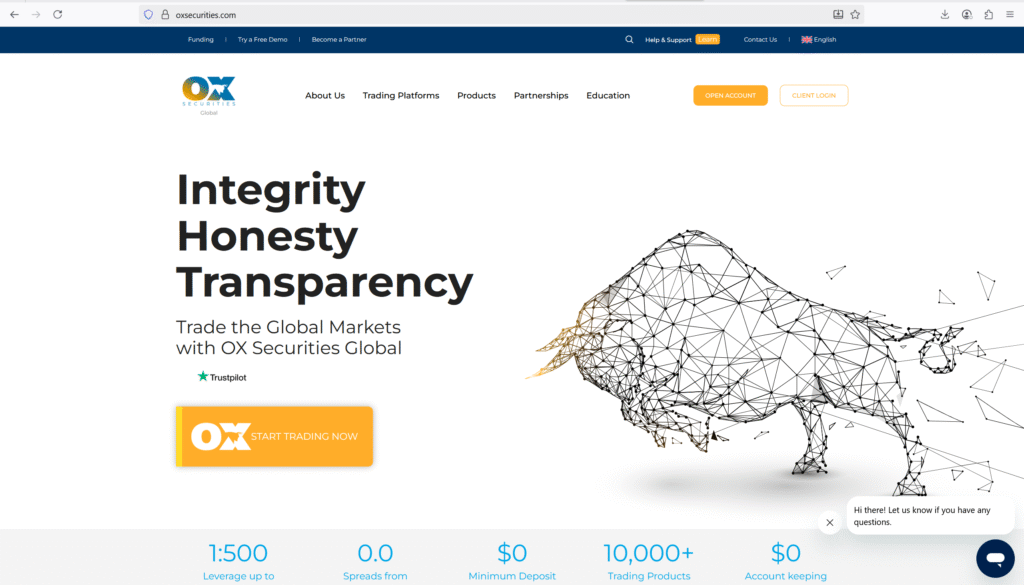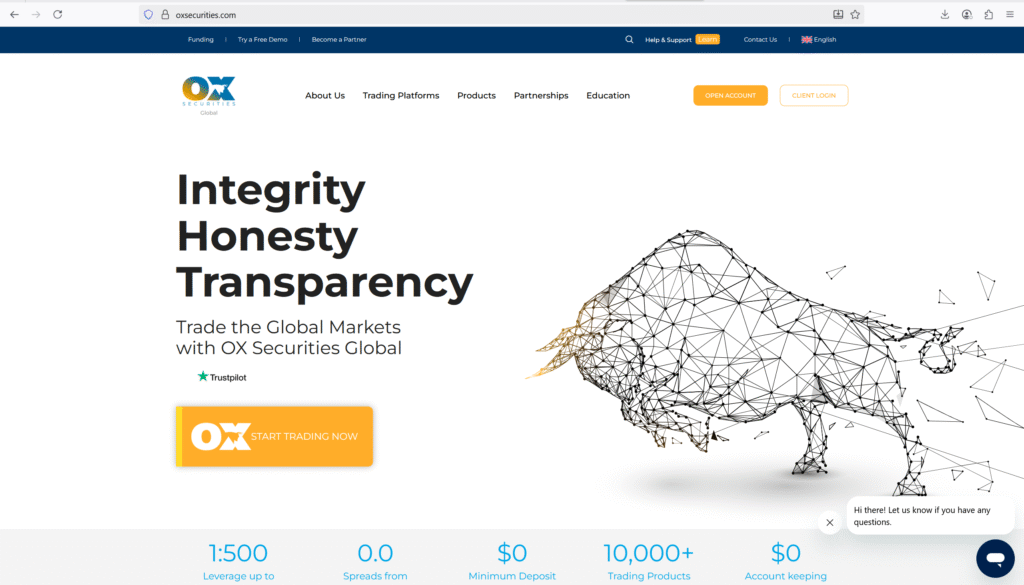OxSecurities.com positions itself boldly in the online trading space, claiming to deliver tight spreads, high leverage, and a global presence. It markets a polished vision: an “upgrade” over traditional brokers, with fast execution, sophisticated platforms, and integrity at its core. But behind that polished interface, many red flags emerge. Below are seven brutal truths that suggest OxSecurities may not be what it claims, exposing the dark underbelly behind their promise of elevated performance.

1. The Upgrade Promise vs. Hidden Execution Control
OxSecurities advertises that it offers “spreads from 0.0,” “leverage up to 1:500,” and “segregated client funds” hallmarks of professional, premium brokers. But these claims demand scrutiny. In many platforms that promise performance upgrades, the actual pricing and order execution are controlled behind the scenes. In user reports, OxSecurities has been accused of operating on a full “B-book” (internal matched trading) model, where client profit is borne internally rather than via real market exposure. If trades never touch real liquidity providers, the “upgrade” is an illusion the firm can control fills, slippage, or even cancel profitable trades under compliance pretexts. Reddit users allege that OxSecurities canceled large profits, citing arbitrage rule violations when accounts became too profitable. That behavior suggests the “upgrade” is conditional on how much you win.
2. Withdrawal Failures: The Exit Trap Is Real
One of the harshest signs of a problematic broker is the inability to withdraw funds. Multiple users report persistent withdrawal issues with OxSecurities. Medium reviews describe clients who were able to deposit and trade, but when it came to cashing out, accounts were frozen, withdrawal requests ignored, or compliance demands made that never ended. On ForexPeaceArmy, a user claims to have made $180,000 in profits, yet saw those profits refused and his account allegedly closed under accusations of violating terms. These withdrawal failures are characteristic of many scam operations: when the game is over, the walls go up.
3. Scammed Testimonials, Shifting Complaints & Mixed Ratings
The public rating profile of OxSecurities is conflicted. On Trustpilot, OxSecurities holds roughly a 4-star rating with several approving reviews praising ease of setup, quick responses, and support. Some users say their first deposits went smoothly. Yet, interspersed amidst praise are reviews complaining of delayed or blocked withdrawals, poor transparency, and ambiguous chargebacks. This contrast suggests a dual strategy: post promotional reviews to maintain public confidence, while quietly managing or suppressing negative experiences. On Reddit, one user explicitly warns of their experience:
“OxSecurities are bucketshop scammers … they have a 100% B-booked model … when I made strong profits they accused me of arbitrage and disowned me.”
Such narratives match the pattern of building facade trust while internal risk controls and exit traps manage only profitable users.
4. Domain Claims vs. Real Regulatory Standing
OxSecurities’ website claims it was established in 2013, offers global services, and presents ideals of “integrity, honesty, transparency.” However, independent broker review platforms label OxSecurities as unregulated or low-regulated, often calling it a “bucket shop.” In one review, it is called “extremely fraudulent and manipulative.” WikiFX reports that users have complained of blocked withdrawals, delays, and misrepresentation of regulation. Meanwhile, OxSecurities claims to operate under multiple license stamps (ASIC, global) but at the same time discloses that Ox Securities Ltd (SVG) is not authorized by the Australian regulator. The discrepancy between public claims and verified licensing status raises serious doubt: if the “upgrade” is legitimacy, it’s a claim without substance.
5. B-Book Matching & Profit Cancellation Allegations
Many user complaints cite that when trading accounts generate substantial profits, OxSecurities cancels trades or refuses payout citing “arbitrage violation” or terms of service breach. One user claims that after turning $190 into $180,000, OxSecurities retroactively flagged arbitrage use and denied payout of profits. That pattern is textbook behavior of B-book models, where the broker takes the position opposite the client. The “upgrade” promise of higher execution only holds for losing trades: winning trades are cancelled or rejected by back-end compliance. That’s how the upgrade becomes selective.
6. Network Hosting & Shared Infrastructure Risk
Scam detection platforms and user reports suggest that OxSecurities operates within hosting networks shared by multiple flagged or suspicious websites. The lack of a uniquely secured infrastructure implies a shared ecosystem of rotating domains or clones. In some reviews, traders mention wire method restrictions or shifts in accepted deposit methods (e.g. only accepting crypto for larger deposits). Where a broker frequently changes deposit channels or forces escrow via less regulated methods, it often signals backend liquidity stress or exit planning. Without a strongly branded, regulated infrastructure, OxSecurities risk being part of a larger scam network rather than a stable broker.
7. Psychological Timing & Escalation of Pressure
From forum comments, it seems OxSecurities uses emotional timing to push clients upward. As client profit grows, “account managers” reportedly encourage larger deposits, promise exclusive access, or threaten missing “premium liquidity windows.” When users request withdrawals, compliance walls appear. The timing is key: the upgrade narrative is offered first, pressure to scale is layered mid-game, and exit barriers occur just as the user expects real profit. This escalation mirrors emotional manipulation used by Ponzi and broker scams alike: push trust first, extract capital next, block exit last.
Conclusion: The Upgrade Illusion That Becomes Your Trap
OxSecurities presents a tempting narrative: the modern broker that upgrades your trading life through tight spreads, high leverage, and broad market access. On its site, it touts transparency, segregated funds, and global presence. But the reality behind that promise differs. For many users, the illusion of upgrade became a trap, a design that rewards depositing but obstructs exiting.
The evidence is consistent: the exit struggles, the canceled profits when accounts get large, the online reputation mix, and the regulatory ambiguity. The most revealing stories are those of traders who turned small sums into significant gains—only to see their withdrawals refused or branded “invalid” under arbitrage or policy violations. These are not stories of market volatility; they are case reports of broker-controlled repudiation.
True brokerage improvement is only meaningful if it works fairly for all trades, not selectively for the broker’s benefit. But for OxSecurities, the upgrade narrative appears conditional. It seems engineered to work only until you win too much. Then invisible walls appear. That is not enhancement—it is deception.
For anyone considering OxSecurities, your first demand must be verifiable proof—license documents, audit logs, real withdrawal transcripts from ordinary clients, and consistent track record over years that holds under scrutiny. If any of these are unavailable, that is itself proof of a problem.
If you or someone you know has deposited funds there, begin damage control now. Attempt small withdrawals and log every detail. Save every screenshot, email, chat, transaction record, and account statement. File complaints with regulators in your country and globally. Engage forensic recovery services if possible in crypto or banking channels. The longer funds sit on a platform with reputation concerns, the more likely they will be moved and lost.
OxSecurities teaches a harsh lesson: the most expensive upgrade you can buy is the one that leads you deeper into a trap. Its sleek interface, bold claims, and veneer of legitimacy mask structural vulnerabilities and dishonest mechanics. In finance, the ultimate measure of a broker is not its branding, but whether it lets you withdraw your gains. In that test, OxSecurities falls short. Don’t trust promises trust withdrawals.



